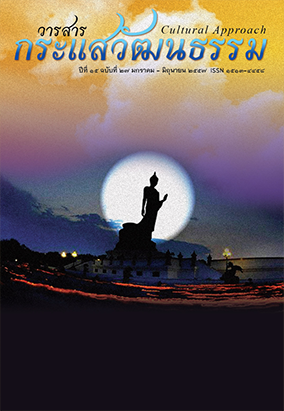ชื่อเรื่อง งานรักริวกิว : ประวัติและเทคนิคการสร้าง
Main Article Content
Abstract
บทคัดย่อ
เครื่องรักของญี่ปุ่นเป็นที่ยอมรับทั่วโลกตั้งแต่อดีตจนถึงปัจจุบัน มีแหล่งผลิตอยู่เกือบทั่วประเทศแม้ขณะ
นี้มีการผลิตน้อยลงตามความต้องการของตลาด เครื่องรักของริวกิวก็เป็นแบบหนึ่งที่ยังมีการสร้างสรรค์อยู่ ริวกิว
เป็นชื่ออาณาจักรโบราณที่เคยตั้งอยู่ที่โอกินาว่า โอกินาว่าเคยเป็นแหล่งผลิตเครื่องรักที่สำคัญมาเป็นเวลานาน
เคยมีการส่งเครื่องรักไปยังจีน ญี่ปุ่น และที่อื่นๆ เครื่องรักริวกิวได้รับการยกย่องในความงดงามและรสชาติด้าน
ศิลปะ
มีเหตุการณ์สำคัญในประวัติศาสตร์ซึ่งส่งผลกระทบต่อสังคมของโอกินาว่าและส่งผลกระทบต่อการผลิต
เครื่องรัก ได้แก่ การบุกรุกริวกิวของ Shimazu ใน ค.ศ.1609 การสถาปนาริวกิวเป็นจังหวัดโอกินาว่า ใน ค.ศ.
1871 และ สงครามมหาเอเชียบูรพาใน ค.ศ. 1942-1945
อย่างไรก็ตามแม้ว่ามีการเปลี่ยนแปลงในด้านรูปแบบและด้านเทคนิค แต่ยังมีการสืบทอด
การสร้างงานมาจนทุกวันนี้ เทคนิคการสร้างงานเครื่องรักโดยเฉพาะเทคนิคการตกแต่งได้มีการปรับเปลี่ยน
มาตลอดตามระยะเวลาตามความนิยม ซึ่งช่วงแรกมีความนิยมกับ Chinkin ถมทอง ต่อมา Aogai ลายมุก
ชนิดบาง และ Tsuikin รักลายนูนตามลำดับ เทคนิคเหล่านี้เบื้องต้นได้รับมาจากจีน แต่ต่อมาพัฒนามาเป็นเครื่อง
รักริวกิวในที่สุด
คำสำคัญ : เครื่องรัก งานช่างรัก ริวกิว โอกินาว่า
เครื่องรักของญี่ปุ่นเป็นที่ยอมรับทั่วโลกตั้งแต่อดีตจนถึงปัจจุบัน มีแหล่งผลิตอยู่เกือบทั่วประเทศแม้ขณะ
นี้มีการผลิตน้อยลงตามความต้องการของตลาด เครื่องรักของริวกิวก็เป็นแบบหนึ่งที่ยังมีการสร้างสรรค์อยู่ ริวกิว
เป็นชื่ออาณาจักรโบราณที่เคยตั้งอยู่ที่โอกินาว่า โอกินาว่าเคยเป็นแหล่งผลิตเครื่องรักที่สำคัญมาเป็นเวลานาน
เคยมีการส่งเครื่องรักไปยังจีน ญี่ปุ่น และที่อื่นๆ เครื่องรักริวกิวได้รับการยกย่องในความงดงามและรสชาติด้าน
ศิลปะ
มีเหตุการณ์สำคัญในประวัติศาสตร์ซึ่งส่งผลกระทบต่อสังคมของโอกินาว่าและส่งผลกระทบต่อการผลิต
เครื่องรัก ได้แก่ การบุกรุกริวกิวของ Shimazu ใน ค.ศ.1609 การสถาปนาริวกิวเป็นจังหวัดโอกินาว่า ใน ค.ศ.
1871 และ สงครามมหาเอเชียบูรพาใน ค.ศ. 1942-1945
อย่างไรก็ตามแม้ว่ามีการเปลี่ยนแปลงในด้านรูปแบบและด้านเทคนิค แต่ยังมีการสืบทอด
การสร้างงานมาจนทุกวันนี้ เทคนิคการสร้างงานเครื่องรักโดยเฉพาะเทคนิคการตกแต่งได้มีการปรับเปลี่ยน
มาตลอดตามระยะเวลาตามความนิยม ซึ่งช่วงแรกมีความนิยมกับ Chinkin ถมทอง ต่อมา Aogai ลายมุก
ชนิดบาง และ Tsuikin รักลายนูนตามลำดับ เทคนิคเหล่านี้เบื้องต้นได้รับมาจากจีน แต่ต่อมาพัฒนามาเป็นเครื่อง
รักริวกิวในที่สุด
คำสำคัญ : เครื่องรัก งานช่างรัก ริวกิว โอกินาว่า
Article Details
How to Cite
Takata, T. (2014). ชื่อเรื่อง งานรักริวกิว : ประวัติและเทคนิคการสร้าง. Journal of Cultural Approach, 15(27), 65–76. retrieved from https://so02.tci-thaijo.org/index.php/cultural_approach/article/view/19771
Section
Research Article
Proposed Creative Commons Copyright Notices
1. Proposed Policy for Journals That Offer Open Access
Authors who publish with this journal agree to the following terms:
- Authors retain copyright and grant the journal right of first publication with the work simultaneously licensed under a Creative Commons Attribution License that allows others to share the work with an acknowledgement of the work's authorship and initial publication in this journal.
- Authors are able to enter into separate, additional contractual arrangements for the non-exclusive distribution of the journal's published version of the work (e.g., post it to an institutional repository or publish it in a book), with an acknowledgement of its initial publication in this journal.
- Authors are permitted and encouraged to post their work online (e.g., in institutional repositories or on their website) prior to and during the submission process, as it can lead to productive exchanges, as well as earlier and greater citation of published work (See The Effect of Open Access).
Proposed Policy for Journals That Offer Delayed Open Access
Authors who publish with this journal agree to the following terms:
- Authors retain copyright and grant the journal right of first publication, with the work [SPECIFY PERIOD OF TIME] after publication simultaneously licensed under a Creative Commons Attribution License that allows others to share the work with an acknowledgement of the work's authorship and initial publication in this journal.
- Authors are able to enter into separate, additional contractual arrangements for the non-exclusive distribution of the journal's published version of the work (e.g., post it to an institutional repository or publish it in a book), with an acknowledgement of its initial publication in this journal.
- Authors are permitted and encouraged to post their work online (e.g., in institutional repositories or on their website) prior to and during the submission process, as it can lead to productive exchanges, as well as earlier and greater citation of published work (See The Effect of Open Access).


